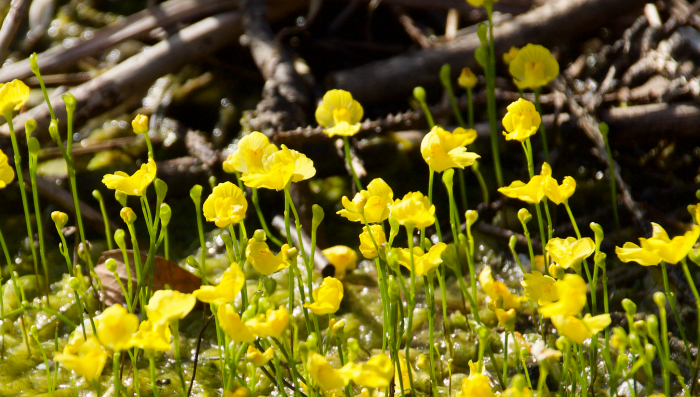Humped Bladderwort
(Utricularia gibba)
Humped Bladderwort (Utricularia gibba)
/
/

Hungry-Sarracenia Photo
CC BY 4.0
Image By:
Hungry-Sarracenia Photo
Recorded By:
Copyright:
CC BY 4.0
Copyright Notice:
Photo by: Hungry-Sarracenia Photo | License Type: CC BY 4.0 | License URL: http://creativecommons.org/licenses/by/4.0/ | Rights Holder: Hungry-Sarracenia Photo | Publisher: iNaturalist | Date Created: 2023-09-09T16:09:54-07:00 |

























Estimated Native Range
Summary
Utricularia gibba, commonly known as humped bladderwort, is an aquatic carnivorous perennial herb. It is native to freshwater habitats such as shallow ponds, lakes, ditches, pools, bogs, swamps, and marshes worldwide, with a preference for nutrient-poor, acidic waters. It often forms dense, free-floating mats of fine, thread-like stolons with small, scale-like leaves and numerous tiny, bladder-like traps that capture small aquatic prey. The plant exhibits a remarkable adaptation to its nutrient-poor environment by supplementing its diet through carnivory. Utricularia gibba blooms throughout the year, producing bright yellow, two-lipped flowers with reddish-brown veins, which are quite showy despite their small size.
This species is valued for its unique carnivorous nature and can be a fascinating addition to water gardens and indoor aquariums. It requires minimal maintenance, as it obtains nutrients from captured prey rather than relying on fertile soil. In cultivation, it prefers full sun to partial shade and must be submerged in water. While it can be a conversation piece for its unusual feeding strategy, Utricularia gibba can become weedy and potentially invasive outside its native range, so caution is advised when introducing it to new areas.CC BY-SA 4.0
This species is valued for its unique carnivorous nature and can be a fascinating addition to water gardens and indoor aquariums. It requires minimal maintenance, as it obtains nutrients from captured prey rather than relying on fertile soil. In cultivation, it prefers full sun to partial shade and must be submerged in water. While it can be a conversation piece for its unusual feeding strategy, Utricularia gibba can become weedy and potentially invasive outside its native range, so caution is advised when introducing it to new areas.CC BY-SA 4.0
Plant Description
- Plant Type: Herb
- Height: 0.1-0.2 feet
- Width: 0.5-1 feet
- Growth Rate: Moderate
- Flower Color: Yellow
- Flowering Season: Spring, Summer, Fall
- Leaf Retention: Deciduous
Growth Requirements
- Sun: Full Sun
- Water: High, Aquatic
- Drainage: Standing
Common Uses
Low Maintenance, Potted Plant, Water Garden
Natural Habitat
Shallow ponds, lakes, ditches, pools, bogs, swamps, and marshes worldwide, with a preference for nutrient-poor, acidic waters
Other Names
Common Names: Humped Bladderwort, Creeping Bladderwort, Conespur Bladderpod, Bolsita De Agua, Manguera, Floating Bladderwort, Swollen-Spurred Bladderwort, Yellow Flowering Bladderwort
Scientific Names: , Utricularia gibba, Megopiza fornicata, Megopiza integra, Megopiza longirostris, Megozipa fornicata, Megozipa integra, Megozipa longirostris, Plesisa bipartita, Trilobulina crenata
GBIF Accepted Name: